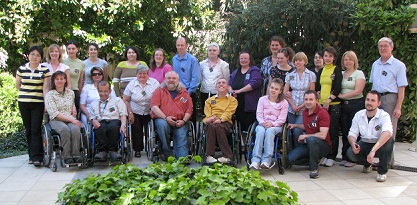‘People with disabilities should be able to participate in every Christian community’
Only in the European Union, 70 million people live with some kind of disability. Churches should “get the issue onto the agenda”, says Thérèse Swinters, facilitator of the European Disability Network.
BRUSSELS · 24 JANUARY 2017 · 19:25 CET

Are churches in Europe including people with disabilities? Are Christians aware of the real needs and opportunities in this area of work?
Thérèse Swinters is the facilitator of the European Disability Network (EDN), a platform that unites organisations and initiatives from several countries. After years of talking with church leaders, she comes to the conclusion that there is still much to do to help “getting the issue of disability onto the agenda”.
Nonetheless, Swinters also expressed her enthusiasm for new opportunities: “In this past week I received several e-mails about Disability issues… Things are suddenly moving !”
ARE CHURCHES THINKING ABOUT PEOPLE WITH DISABILITIES?
In the European Union, 70 million people aged 15 and over reported a disability in 2012, 18% of the total population.
Almost 6 in 10 people with some kind of disability are women.

“This is especially the case in churches where people often think ‘we are all accepted by the Lord’ and conclude that there in no need to take any special action about disabled people”.
CHURCH LEADERS NEED TO GROW IN VISION
Why are networks and ministries offering training in this field? Because Christians “need a united effort to ensure that we think carefully and thoroughly about the issues of disability. Not because we want to separate these people as a specialist ‘care’ area, but to include them in the whole community as teachers, pastors, counselors and disciples, etc…”
This inclusion is not an issue of “getting people in a wheelchair into the church”. There are other more difficult areas “such as including learning disabled and deaf people in our study programs”.
“As Tony Phelps Jones of Prospects UK puts it, ‘the good news is that when a church works hard at being a better place for disabled people, it becomes a better place for everybody’”.

Church leaders with no disabilities still have much work to do to “understand” people who live with disabilities. “Churches do not so much have to ‘care, nurse, pay for wheelchairs, etc.’ but should take responsibility so that people living with a disability can participate in the Christian communities.”
Real friendships with people who live with a disability turn into a chance to learn about “how to face suffering”, Swinters explains.
“CAN I HELP YOU? … HOW?”
But not only leaders need to grow in vision, but everyone else. There are good intentions, and “Christians are normally loving and caring, but very often they don’t know when and how to help”.
And “people with a disability do not like to be patronised, and ‘well-intentioned actions’ are often misunderstood”. A good start is always to think: ‘am I doing this to serve this person or just to feel good with myself?’
Initiatives need to come into place through relationships. “Every Christian should train themselves in taking contact with people with a disability”.
One cannot help if he/she doesn’t know what is actually needed. “A person living with a disability always says: ‘Nothing about me, without me’”.

“A disabled person can very often decide for him/herself what he/she likes to do or how things should be done”. So, “the most important question in getting involved in disability is: ‘Can I help?’ Only after listening to the answer, then the next question can be: ‘How can I help?’”
She underlines this: it is very important to “listen very careful to every detail of the answer”.
A PERSONAL EXAMPLE: THE WHEELCHAIR
Swinters shares an example of her own life. She uses a wheelchair, even in unfamiliar areas and longer distances (more than 50 meters). “I can put my wheelchair in and out my own car. But sometimes people want to help, but they do not ask me first, and that creates a difficulty for me. When people put the wheelchair in the car without my indications, I cannot take my wheelchair out on my own at home. And there is nobody to help”.
“So, very often I tell people I will put my wheelchair in the car on my own, but then they have the impression that I don’t like them to tell me that I need help. Or they feel embarrassed because they think they should not have asked”.
Such situations could be solved much more easily if people just took the time to ask and to listen well.
DIFFERENCES THROUGHOUT EUROPE
What about the help offered by the governments? Swinters makes a distinction between Eastern Europe and Western Europe.

“The most obvious difference is that in the west, most governments are taking care of the financial needs for daily live. Living at home with a disability requires adaptations to the home: bedroom, bathroom, doors, stairs, etc. Add to that finances for wheelchairs, prostheses, adapted computer, etc.”
In many countries, “more and more finances are released for daily companionship and help in everyday activities (somebody who is available to make meals, help with bathroom visit, shopping, outing) and overall assisting in the opportunity to live on their own for physical disabled as well as for people with learning disabilities, mental impairments and stabilised mentally ill people”.
In contrast, “those payments are not or almost not available” in Eastern European countries. Swinters believes this could be related to the “attitude towards disability” and Human Rights in general, and to the impact faith has had in these countries in the past.
Read the second part of this interview with Thérèse Swinters.
Published in: Evangelical Focus - life & tech - ‘People with disabilities should be able to participate in every Christian community’
